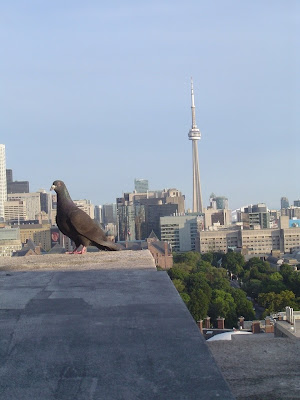A big part of this emotional resonance comes from the huge range of characters the eight-member troupe play: flirty girls, corporate Bay Street types, homeless people, workmen, yuppies, activists, musicians, immigrants, eccentrics, even friendly fast-food competition. They’re all here, refreshingly free of predictable stereotypes. The choice of using the music of Aram Khachaturian further conveys the international flavour of the work. After all, there are any number of local, beloved bands that could’ve stepped up (Broken Social Scene, anyone?) but with Marton at the helm, Window On Toronto takes on a uniquely worldly air. Yes, it is intended to be squarely in Toronto, but… it’s really everywhere.
The show maintains the Hungarian director’s European flair for timeless imprecision -which, in turn, gives Toronto a kind of European quality (take that, Montreal!). The famous “Saber Dance” is played a few times as cast members hurriedly move back and forth, in circles, up, down, and whirling into pace, within the frame of the vendor’s window, though the show starts simply enough, with raindrops covering the window. Marton adds a nice, meta-theatrical touch, by having the vendor himself (Jason Patrick Rothery, named, appropriately, “Jason”) sit in the front row seat, in effect becoming the audience to a continuous cavalcade of drama, comedy, and absurdity that unfolds before him over the course of a year.
That cavalcade includes a series of recurring, and deeply fascinating, characters. These include a Korean immigrant (played by Ins Choi) who befriends the vendor, and regularly comes around, first to introduce his wife, and later, his baby. There’s a braided flirty girl who loves sauerkraut (Karen Rae). There’s a quietly menacing man on a bike who comes to the window, looks around the window, silently takes notes, and rides off (Gregory Prest). There’s a lawyer-type who keeps our fearless vendor apprised of the ever-changing social situation, and leaves with a mantra-like “call me!” (Brendan Wall). There’s a hungry-looking woman in a hijab with a baby in her arms (Tatjana Cornij). There’s a protestor with hurting eyes (Ryan Field). There’s a potential love interest (Raquel Duffy) whose own pregnancy offers a quietly poignant moment. There’s a gay couple (who display remarkable “skating” skills during the winter scene, which comes complete with Strauss music to accompany). There are also impressive musical interludes performed by the cast. Touching on mime and even commedia traditions, these interludes aren’t so much diversions as they are vignettes in and of themselves. The play of colour, light, and shadow in these moments is truly inspiring, and offers some poetic grace amidst the urban hustle, in the same way that stopping and sitting on a park bench in Nathan Phillips Square -or any piazza – might.

Director Marton, together with designer
Ken Mackenzie, gracefully make use of the small square in the middle of the stage, utilizing all manner of colour, texture, light, and shape. Faces, bodies, and various objects (except, interestingly, food or money) are placed in and around the frame, offering us a small peek at the world. White gloves pop up in one vignette, with thumbs and forefingers acting as hungry mouths. Eyes peek from around the top sides. What’s shown is every bit as interesting as what isn’t; bikes go by, people rollerblade, there are shouts and laughs and various bits of drama that remind us about all the untold stories in any given urban area. With one small window, Mackenzie effectively conveys the vast expanse of the space around City Hall through one heck of a great design that incorporates a number of different elements. For instance, when a piano is (mistakenly) delivered to the vendor, it’s conveniently used in that particular vignette, and in subsequent scenes, both within and without the frame proper. Its music echoes past the walls of the set, going past a visual experience of theatre and embracing an intimate aural one. Never has the music of the city seemed so obvious or lovely.
Along with noise and energy, there are moments of quiet and contemplation. There’s something enchanting in these moments -past the comedy, the chaos, and the bustle. It’s like a reminder to all of us who rush between emails, Starbucks, meetings, and bars: just stop, sit, listen, and look at the world around you. Maybe you’ll chomp on a hot dog. Listen, look, feel. It’s so simple. That is the magic of Window On Toronto, and indeed, of urban life everywhere.


